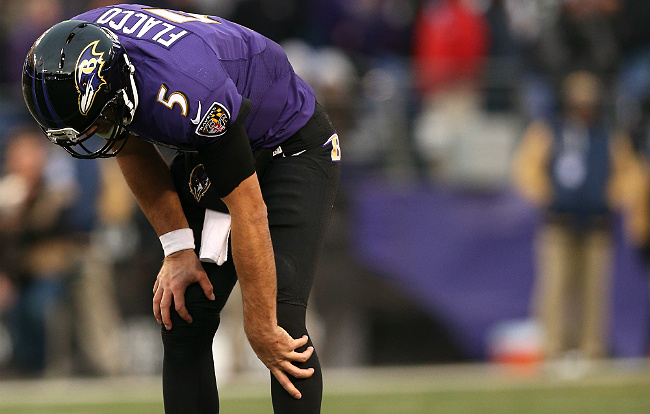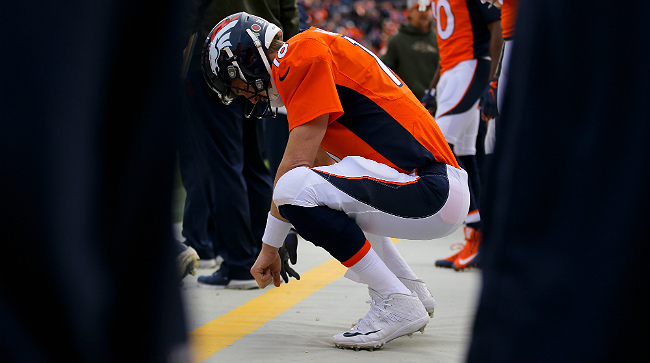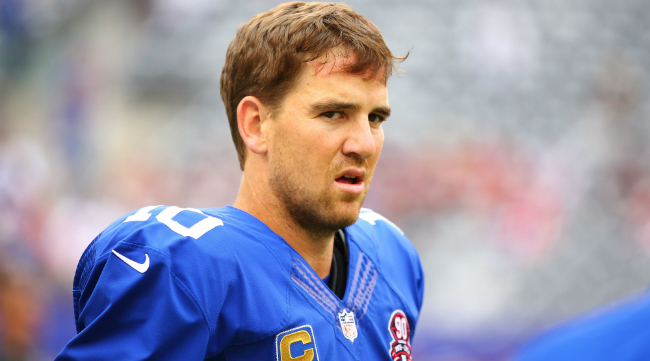
At the end of a meaningless win in a miserable season, Joe Flacco had his left knee shredded into cheddar when a backup left tackle rolled into his leg. And like that, Flacco will miss the first game in his career due to injury. His replacement? Matt Schaub. The last non-Flacco quarterback to start a game for the Ravens, all the way back in the final week of a woeful 2007 season? Troy Smith. In fact, save for a single play by punter Sam Koch, Flacco had thrown every pass this season for Baltimore. The cold offseason came early and it came sudden.
Baltimore fans have lots of company in this area. The 49ers — a mere husk of an NFL franchise at this point — lost Colin Kaepernick last week to a torn labrum and his time with San Francisco may be done. The Broncos have been winning all season in spite of Peyton Manning, but now he might be done for the year if Brock Osweiler continues to play like Tall Tim Tebow. Tony Romo is back for Dallas but about eight weeks too late to save that team. In September, Drew Brees missed his first game due to injury in a 15-year career. Ben Roethlisberger and Jay Cutler have also missed chunks of time with various ailments. And Geno Smith was supposed to be the starter for the Jets but a teammate’s right hook effectively shelved his year before it began.
Throw all that in a blender and, well, you’d have the world’s worst milkshake. But toss in the glaringly uncertain situations with Philadelphia, St. Louis, Cleveland, and Kansas City — where you can safely say the franchise quarterback of the future is not currently with said franchise — as well as a weak incoming NCAA draft class and a less-than-inspiring free agent market in 2016 (Kirk Cousins! Ryan Fitzpatrick!), and you have a pretty depressing situation shaping up.

This is the state of the NFL quarterback in November 2015 and it is not a very confident or healthy state. The logic of the modern NFL dictates that we are protecting QBs as never before and the penalties are so disincentivizing that elite QBs should be ruling the NFL with near-reckless abandon. And in many ways, the NFL has never been more of a passing league than it is now.
This season’s current average of 1.64 receiving touchdowns per team game would be the highest recorded in NFL history, with the four of the 10 highest rates coming in each of the last four seasons. And the number of rushing TDs per game (0.71) is at its lowest level since 1993. The imbalance right now between passing and rushing is gaping and still growing. (This is actually something the Canadian Football League figured out decades ago, but they pulled it off not by encasing quarterbacks in invisible, carbon-fiber bubbles and hoping for several future Hall of Famers to play well into their late 30s but with a larger field, an extra player on offense, and allowing multiple players in motion, which makes the offense move a little more creatively, but all that’s for another discussion.)
To a certain extent, this is the time of the season when you’re going to see some unfamiliar names among the passing leaders simply because professional football is, at its core, a game of attrition and it’s damn hard to stay healthy over 17 weeks, let alone for another month of playoff games. But look at some names among Week 11 passing leaders in 2013 and 2014 vs. this year’s:
2013: Mike Glennon, Ryan Fitzpatrick, Matt McGloin, Josh McCown, Chad Henne, Case Keenum, Scott Tolzien, Matt Schaub, Christian Ponder
2014: Josh McCown, Zach Mettenberger, Shaun Hill, Ryan Mallett, Drew Stanton, Matt Cassel, Jason Campbell
2015: Brock Osweiler, Blaine Gabbert, T.J. Yates, Case Keenum, Mark Sanchez, Ryan Fitzpatrick, Matt Hasselbeck
This is probably not what the suits on Park Avenue want to see — maybe next year we can have Cam Newton vs. Tom Brady for 16 games, head to head, who says no? — but there’s a reason why we get to this point in this season and you start seeing some of those same familiar backup QB names pop up. Professional football, as we are constantly reminded, is a violent, contact sport in which one’s career could be over on any single play.

In a way, it’s amazing that a player like, say, Eli Manning, who has the longest active QB starting streak at 177 games, can go as long as he can without a major in-season injury. But if Manning snapped his Achilles on Sunday against Washington, would anyone actually be surprised?
There’s really not much more the NFL can do to protect quarterbacks short of electrifying their jersey fabric with mini-cattle prods, but the NFL’s core product (the act of a quarterback throwing a touchdown) suffers mightily when Manning, Brees, Roethlisberger, Cutler, Romo and their ilk are down and out or even clearly compromised. The problem will be the reckoning that occurs when these older playcallers — Tom Brady wanting to play into his late 40s notwithstanding — have to hang up the cleats and the next generation is forced to take over.
Cam Newton gives me hope for the future. Same for Marcus Mariota, Derek Carr, and Teddy Bridgewater. Maybe Blake Bortles and Jameis Winston will turn out to be good, longtime players. There used to be more time to develop young quarterbacks, but those days are largely gone. And when the marquee names that don’t usually get injured start getting injured, it accelerates an already hastened cycle. Some young QBs have adapted well, but with 32 teams, there’s always going to be work for a Mark Sanchez or Ryan Fitzpatrick or Josh McCown. It’s not the NFL that the NFL wants, but it’s the only one we got.






